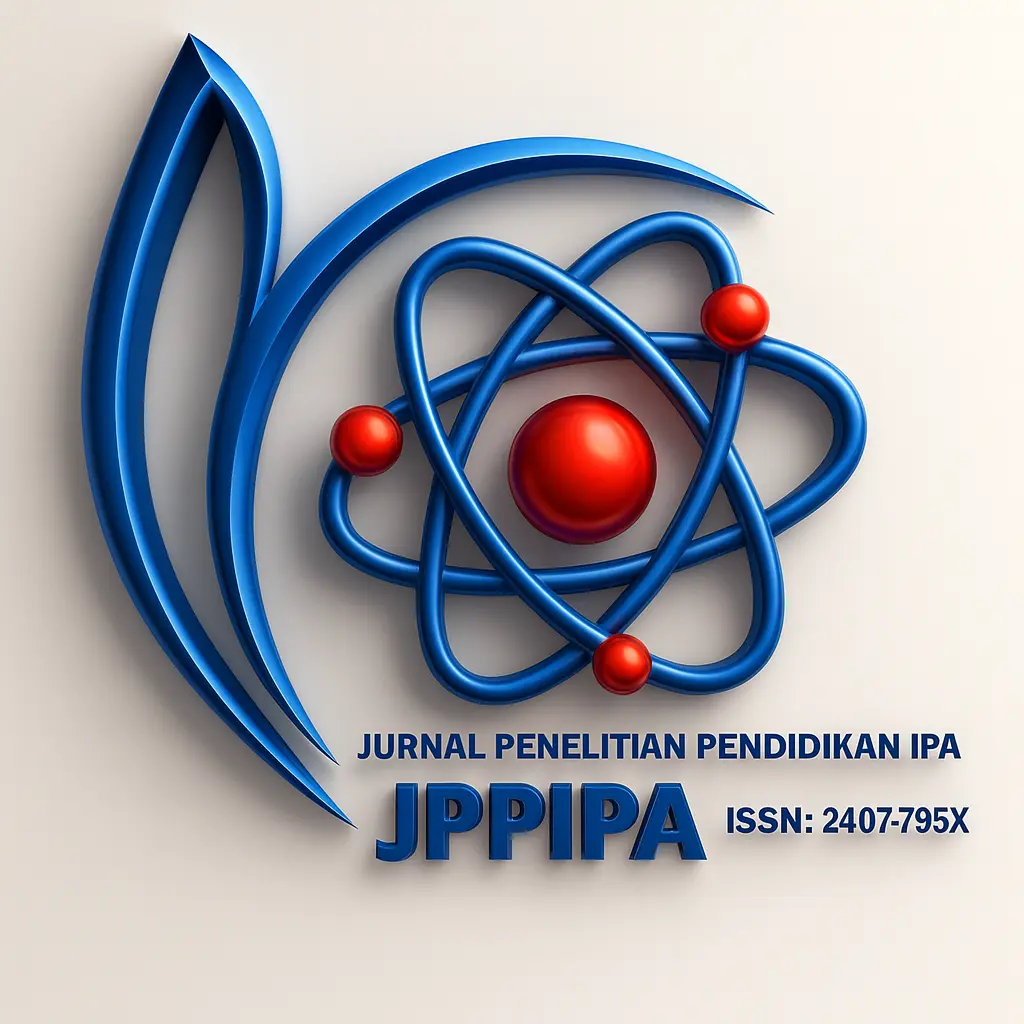Forest Honey Cream Formulation and Test of Its Effectiveness in Accelerating Burn Wound Healing
DOI:
10.29303/jppipa.v11i5.11185Published:
2025-05-25Downloads
Abstract
Honey contains various essential nutrients, including carbohydrates, proteins, amino acids, vitamins, minerals, dextrin, plant pigments, and natural compounds. This study aims to develop the formulation and effectiveness of forest honey cream as a therapeutic agent for second-degree burns. The research design used was a pure experimental laboratory. This study used five rabbits divided into five treatment groups. Burns were given on the first day and treatment was given every day. Observations were made every three days for 15 days. Statistical analysis was carried out using a Completely Randomized Design (CRD), and the Least Significant Difference (LSD) test, by comparing the condition of the wound before and after treatment, as well as the control group that was not given treatment. The results of the study showed that based on the test of the effectiveness of healing burns between the 30% concentration honey cream group when compared to the positive control group (Biopacenton® ointment) showed a difference but was not very significant (0.03 < 0.07). The calculated F value is greater than the F table at the level of α = 0.05 (8.70 > 2.78) so the hypothesis Ho is rejected and Ha is accepted which means that there is a significant influence/effect of administering high concentration forest honey cream formulation on burns in rabbit test animals. In conclusion, the application of forest honey at a higher concentration significantly improves burn healing in the rabbit model. Further research is recommended to investigate the optimal frequency of forest honey application to further accelerate the burn healing process.
Keywords:
Biopacenton ointment, Burns, Honey creamReferences
Atis, A. (2020). Studi Literatur: Efek Penggunaan Madu sebagai Tonikum (Diploma Thesis). Universitas Muhammadiyah Mataram. Retrieved from https://repository.ummat.ac.id/1587/
Apriana, W., Hidayat, U. R., & Hardika, R. (2019). Pengaruh Pemberian Madu sebagai Antibiotik Saat Pemasangan Terapi Intravena Terhadap Pencegahan Flebitis di Instalasi Gawat Darurat Rumah Sakit X Pontianak. Khatulistiwa Nursing Journal, 1(1), 19–28. https://doi.org/10.53399/knj.v1i1.42
Apriyani, A. (2023). Pengaruh Pendidikan Kesehatan Terhadap Pengetahuan Tentang Pertolongan Pertama Penatalaksanaan Luka Bakar. Jurnal Inspirasi Kesehatan (JIKA), 1(1), 80–94. https://doi.org/10.52523/jika.v1i2.86
Asiah, R. H., Hilmawati, R., Siwi, D. B., & Dhari, W. (2018). Madu. ResearchGate, 8(October).
Attsani, A. R. Q., Fikra, H., Tamami, T., & Naan, N. (2022). Khasiat Madu bagi Kesehatan Tubuh: Studi Takhrij dan Syarah Hadis. The 2nd Conference on Ushuluddin Studies, 8, 542–552. Retrieved from https://conferences.uinsgd.ac.id/index.php/gdcs/article/view/614
Awaluddin, A., & Sugiyanto, S. (2022). The Effect of Ankle Pumping on the Changes of ABI Value in Diabetic Neuropathic Patients. Jurnal Keperawatan, 13(1), 71–76. https://doi.org/10.22219/jk.v13i1.14254
Gunawan, N. A. (2017). Madu: Efektivitasnya untuk Perawatan Luka. Continuing Professional Development, 44(2), 138–142. Retrieved from https://media.neliti.com/media/publications/399678-madu-efektivitasnya-dalam-untuk-perawata-4e029ab4.pdf
Hasbi, N., Rosyunita, R., Rahim, A. R., Wardoyo, E. H., Arnawati, I. A., Haza, S. S., Hulfifa, L. N., Alamsyah, A. D. C. F., & Validika, I. K. S. (2023). Phytochemical Screening and Antibacterial Activity Test of Sumbawa White Honey Against Bacillus megaterium. Jurnal Penelitian Pendidikan IPA, 9(10), 8707–8712. https://doi.org/10.29303/jppipa.v9i10.4913
Hendy, H., & Lister, I. N. E. (2019). Tingkat Efektivitas Penyembuhan Luka Bakar Derajat IIA dengan Pemberian Madu dan Pemberian Salep Nebacetin pada Tikus Putih (Rattus norvegicus). Jurnal Kedokteran dan Kesehatan, 15(2), 130. https://doi.org/10.24853/jkk.15.2.130-134
Kholil, K. (2020). Deskripsi Madu Trygona (p. 27). Retrieved from http://repository.usahid.ac.id/1139/1/DESKRIPSI PRODUK1.pdf
Khumaidi, K., Fitra, L., & Isnayati, I. (2022). Perawatan Luka dengan Madu dalam Penyembuhan Luka Diabetikum pada Pasien Diabetes Melitus. Journal of Nursing Innovation, 1(1), 1–4. https://doi.org/10.61923/jni.v1i1.1
Notoatmojo, S. (2018). Metodologi Penelitian Kesehatan. Jakarta: Rineka Cipta.
Rusyanti, S., Yuningsih, N., & Yani, A. (2024). Consumption of Black Honey Accelerates Perineal Wound Healing in Postpartum Mothers. Jurnal Penelitian Pendidikan IPA, 10(12), 11204–11210. https://doi.org/10.29303/jppipa.v10i12.8696
Sakri, F. M. (2022). Madu dan Khasiatnya: Suplemen Sehat Tanpa Efek Samping. Jakarta: Diandra Pustaka Indonesia.
Sigala, A. (2021). Formulasi dan Efektifitas Krim Madu Hutan untuk Terapi Luka Bakar pada Kelinci (Oryctolagus cuniculus). JIKP: Jurnal Ilmiah Kesehatan Pencerah, 10(2), 140–151.
Sigala, A., & Sugiyanto, S. (2022). Formulasi dan Efektifitas Krim Madu Hutan dari Daerah Suli Barat Kabupaten Luwu untuk Terapi Luka. Jurnal Fenomena Kesehatan, 5(1), 31–42. Retrieved from https://ojs.ikbkjp.ac.id/jfk/article/view/151/114
Sinulingga, E. H., Budiastuti, A., & Widodo, A. (2018). Efektivitas Madu dalam Formulasi Pelembap pada Kulit Kering. Diponegoro Medical Journal (Jurnal Kedokteran Diponegoro), 7(1), 146–157. Retrieved from http://ejournal3.undip.ac.id/index.php/medico
Sugiyanto, S., & Sumarni, S. (2022). Pengaruh Senam Kaki Diabetik Terhadap Perubahan Kadar Gula Darah pada Pasien DM Tipe 2 Non Ulkus. Jurnal Fenomena Kesehatan, 05(01), 1–8. Retrieved from https://www.ojs.ikbkjp.ac.id/index.php/JFK/article/view/145/111
Sugiyono, S. (2018). Metode Penelitian Kombinasi (Mixed Methods). Bandung: CV. Alfabeta.
Wulandari, D. D. (2017). Kualitas Madu (Keasaman, Kadar Air, dan Kadar Gula Pereduksi) Berdasarkan Perbedaan Suhu Penyimpanan. Jurnal Kimia Riset, 2(1), 16–22. https://doi.org/10.31938/jsn.v6i2.160
License
Copyright (c) 2025 Sugiyanto, Aprianti Sigala, Putri Clara

This work is licensed under a Creative Commons Attribution 4.0 International License.
Authors who publish with Jurnal Penelitian Pendidikan IPA, agree to the following terms:
- Authors retain copyright and grant the journal right of first publication with the work simultaneously licensed under a Creative Commons Attribution 4.0 International License (CC-BY License). This license allows authors to use all articles, data sets, graphics, and appendices in data mining applications, search engines, web sites, blogs, and other platforms by providing an appropriate reference. The journal allows the author(s) to hold the copyright without restrictions and will retain publishing rights without restrictions.
- Authors are able to enter into separate, additional contractual arrangements for the non-exclusive distribution of the journal's published version of the work (e.g., post it to an institutional repository or publish it in a book), with an acknowledgment of its initial publication in Jurnal Penelitian Pendidikan IPA.
- Authors are permitted and encouraged to post their work online (e.g., in institutional repositories or on their website) prior to and during the submission process, as it can lead to productive exchanges, as well as earlier and greater citation of published work (See The Effect of Open Access).









